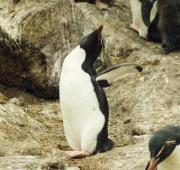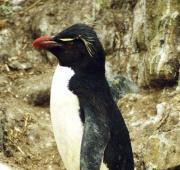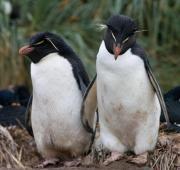 The rockhopper penguin is a group of penguins that are closely related and share the same love of jumping over rocks to get about, rather sliding around on their bellies in the normal penguin fashion. There are three different species of rockhopper penguin which are the western rockhopper penguin, the eastern rockhopper penguin and the northern rockhopper penguin.
The rockhopper penguin is a group of penguins that are closely related and share the same love of jumping over rocks to get about, rather sliding around on their bellies in the normal penguin fashion. There are three different species of rockhopper penguin which are the western rockhopper penguin, the eastern rockhopper penguin and the northern rockhopper penguin. Rockhopper penguins are found throughout the sub-Antarctic and in regions of the southern Indian and Pacific Oceans. The regions occupied by the rockhopper penguin depend on the species. The western rockhopper is found around the tip of the South America; the eastern rockhopper breeds on sub-Antarctic islands of the Indian and western Pacific oceans and the northern rockhopper penguin breeds on islands of Tristan da Cunha as well as on Amsterdam and St Paul Islands.
Rockhopper penguins are found throughout the sub-Antarctic and in regions of the southern Indian and Pacific Oceans. The regions occupied by the rockhopper penguin depend on the species. The western rockhopper is found around the tip of the South America; the eastern rockhopper breeds on sub-Antarctic islands of the Indian and western Pacific oceans and the northern rockhopper penguin breeds on islands of Tristan da Cunha as well as on Amsterdam and St Paul Islands.


The rockhopper penguin is a carnivorous animal, that like all other penguin species, survives on a diet that is only comprised of marine animals. Krill and small crustaceans make up the bulk of the rockhopper penguin's diet along with larger organisms including squid and various species of fish. Rockhopper penguins can be at sea for days at a time whilst hunting and catch their food by diving deep into the water for minutes at a time.
The rockhopper penguin has no natural land-based predators due to the fact that rockhopper penguins inhabit pretty harsh environments, uninhabitable to other animals . Large leopard seals hunt the rockhopper penguin in the water along with large sharks and killer whales. Rockhopper penguin population have also been seriously affected by human hunting, and are easily affected by changes in the water from oil spills and chemical pollutants.
Rockhopper penguins nest on beaches, high up on the cliffs and sometimes inland on islands throughout the sub-Antarctic (these sites are known as rookeries). The female rockhopper penguin lays two eggs which are incubated for just over a month and usually fledge (leave the nest) when they are between 2 and 3 months old.
Today, the rockhopper populations throughout the southern hemisphere have been drastically declining and all three species are now at risk. The northern rockhopper penguin is classified as endangered, where the others are not quite in as much danger.

